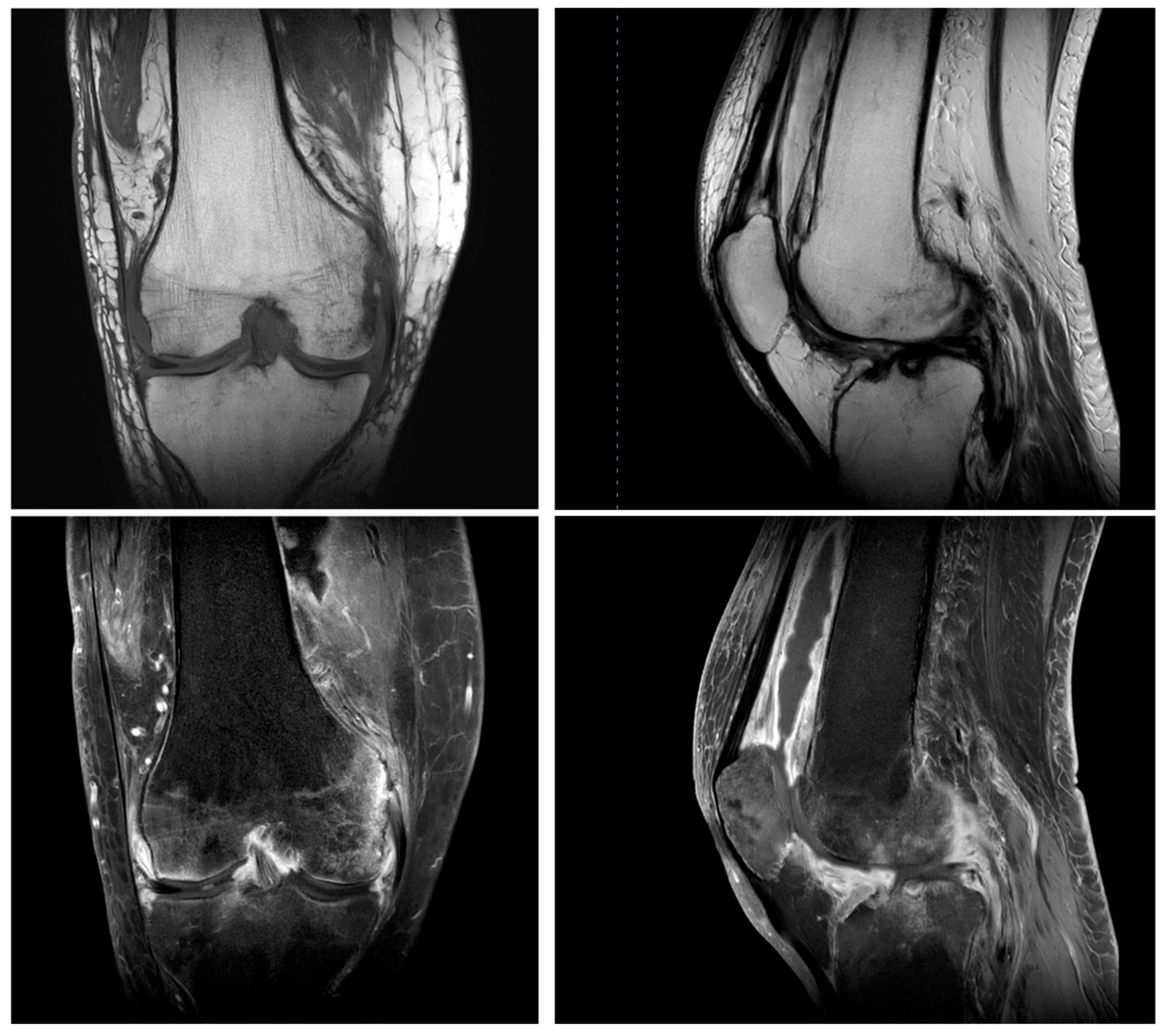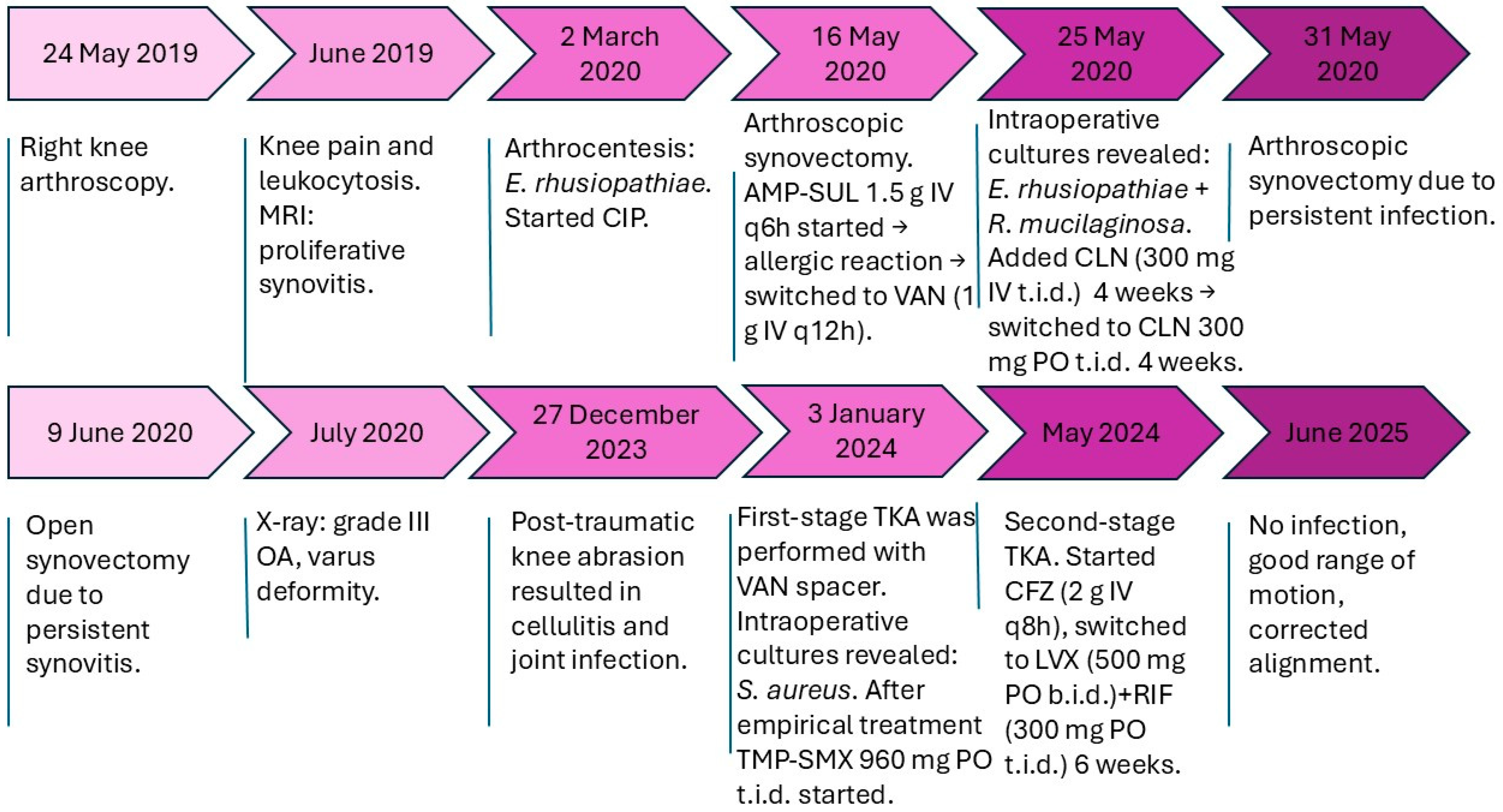Knee Septic Arthritis Caused by Coinfection with Rothia mucilaginosa and Erysipelothrix rhusiopathiae
Abstract
1. Introduction
2. Case Presentation
3. Discussion
| Erysipelothrix rhusiopathiae | Rothia mucilaginosa | Present Case (Coinfection) | |
| Number of reported cases (authors) | 3 (Ruiz ME 2003 [2]; Vallianatos PG 2003 [13]; Neumann DRP 2009 [18]) | 1 (Daoub A 2021 [4]) | 1 (present case) |
| Demographics | Male, 18–76 years old | Female, 58 years old | Male, 59 years old |
| Epidemiological history | (1) Gardening and fishing; (2) 8 days after an arthroscopic anterior cruciate ligament reconstruction; (3) Farmer, osteoarthritis. | Bilateral knee osteoarthritis treated with osteotomy and intra-articular steroid injections (at 12 months and 3 days before admission), dental procedure (2 weeks before symptoms) | Knee arthroscopy due to pathology of the meniscus, osteoarthritis |
| Microorganisms | E. rhusiopathiae | R. mucilaginosa | E. rhusiopathiae + R. mucilaginosa |
| Antibacterial treatment and duration | (1) Penicillin IV 4 weeks; (2) IV 6 weeks -> oral 16 weeks; (3) Penicillin IV 3 weeks -> amoxicillin–clavulanate 3 weeks. | Empirical vancomycin -> flucloxacillin and co-trimoxazole IV 2 weeks -> oral linezolid | Empirical vancomycin -> vancomycin and clindamycin IV 4 weeks -> oral clindamycin 4 weeks (6 weeks after last surgery) |
| Surgical interventions (number) | (1) Repeated knee arthrocentesis; (2) Arthroscopic lavage and debridement; (3) Arthroscopic debridement -> total knee arthroplasty 6 months after the first presentation and recovery (for concomitant osteoarthritis). | Arthrocentesis, three arthroscopic lavages, surgical treatment to treat osteoarthritis will be considered at 1 year post-discharge | Two arthroscopic synovectomies, one open synovectomy -> two-stage total knee arthroplasty for infection (S. aureus) and concomitant osteoarthritis |
| Outcome | Full recovery in all cases | Full recovery | Full recovery |
4. Conclusions
Author Contributions
Funding
Institutional Review Board Statement
Informed Consent Statement
Data Availability Statement
Acknowledgments
Conflicts of Interest
Abbreviations
| MRI | Magnetic resonance imaging |
| TKA | Total knee arthroplasty |
| WBC | White blood cells |
| RBC | Red blood cells |
| CRP | C-reactive protein |
| NE | Neutrophils |
| ESR | Erythrocyte sedimentation rate |
| PLT | Platelets |
| MN | Mononuclear cells |
| PMN | Polymorphonuclears |
| AMP-SUL | Ampicillin–sulbactam |
| CIP | Ciprofloxacin |
| CLN | Clindamycin |
| VAN | Vancomycin |
| TMP-SMX | Trimethoprim–sulfamethoxazole |
| CFZ | Cefazolin |
| LVX | Levofloxacin |
| RIF | Rifampicin |
| OA | Osteoarthritis |
References
- Janse, T.S.; Schermerhorn, D.F.; Colantonio, D.T.; Larson, R.J.; McGill, R.J. A case of periprosthetic joint infection because of Rothia mucilaginosa. Mil. Med. 2023, 188, e894–e897. [Google Scholar] [CrossRef]
- Ruiz, M.E.; Richards, J.S.; Kerr, G.S.; Kan, V.L. Erysipelothrix rhusiopathiae septic arthritis. Arthritis Rheum. 2003, 48, 1156. [Google Scholar] [CrossRef] [PubMed]
- Maillard, A.; Wakim, Y.; Itani, O.; Ousser, F.; Bleibtreu, A.; Caumes, E.; Monsel, G. Osteoarticular infections caused by Erysipelothrix rhusiopathiae: Case report and literature review. Open Forum Infect. Dis. 2021, 8, ofab461. [Google Scholar] [CrossRef] [PubMed]
- Daoub, A.; Ansari, H.; Orfanos, G.; Barnett, A. Rothia mucilaginosa: A case of septic arthritis in a native knee and review of the literature. BMJ Case Rep. 2021, 14, e237015. [Google Scholar] [CrossRef] [PubMed]
- Veraldi, S.; Girgenti, V.; Dassoni, F.; Gianotti, R. Erysipeloid: A review. Clin. Exp. Dermatol. 2009, 34, 859. [Google Scholar] [CrossRef] [PubMed]
- Elvy, J.; Hanspal, I.; Simcock, P. A case of Erysipelothrix rhusiopathiae causing bilateral endogenous endophthalmitis. J. Clin. Pathol. 2008, 61, 1223. [Google Scholar] [CrossRef] [PubMed]
- Meric, M.; Ozcan, S.K. Erysipelothrix rhusiopathiae pneumonia in an immunocompetent patient. J. Med. Microbiol. 2012, 61, 450. [Google Scholar] [CrossRef] [PubMed]
- Ekkelenkamp, M.B.; Rooijakkers, S.H.M.; Bonten, M.J.M. Chapter 165—Staphylococci and micrococci. In Infectious Diseases, 3rd ed.; Cohen, J., Opal, S.M., Powderly, W.G., Eds.; Mosby: St. Louis, MO, USA, 2010; pp. 1632–1644. [Google Scholar] [CrossRef]
- Verrall, A.J.; Robinson, P.C.; Tan, C.E.; Mackie, W.G.; Blackmore, T.K. Rothia aeria as a cause of sepsis in a native joint. J. Clin. Microbiol. 2010, 48, 2648–2650. [Google Scholar] [CrossRef] [PubMed]
- The European Committee on Antimicrobial Susceptibility Testing (EUCAST). Guidance: What to Do When There Are No Breakpoints; EUCAST: Växjö, Sweden, Revised February 2024. Guidance: What to Do When There Are No Breakpoints. Available online: https://www.eucast.org/clinical_breakpoints_and_dosing/when_there_are_no_breakpoints (accessed on 28 August 2025).
- Ramanan, P.; Barreto, J.N.; Osmon, D.R.; Tosh, P.K. Rothia bacteremia: A 10-year experience at Mayo Clinic, Rochester, Minnesota. J. Clin. Microbiol. 2014, 52, 3184–3189. [Google Scholar] [CrossRef] [PubMed]
- Momodu, I.I.; Savaliya, V. Septic Arthritis. In StatPearls [Internet]; StatPearls Publishing: Treasure Island, FL, USA, 2023. Available online: https://www.ncbi.nlm.nih.gov/books/NBK538176/ (accessed on 30 April 2025).
- Vallianatos, P.G.; Tilentzoglou, A.C.; Koutsoukou, A.D. Septic arthritis caused by Erysipelothrix rhusiopathiae infection after arthroscopically assisted anterior cruciate ligament reconstruction. In Arthroscopy; 2003; 19, p. e16. Available online: https://pubmed.ncbi.nlm.nih.gov/12627143/ (accessed on 30 April 2025).
- Trivedi, M.N.; Malhotra, P. Rothia prosthetic knee joint infection. J. Microbiol. Immunol. Infect. 2015, 48, 453–455. [Google Scholar] [CrossRef] [PubMed]
- Mahobia, N.; Chaudhary, P.; Kamat, Y. Rothia prosthetic knee joint infection: Report and mini-review. New Microbes New Infect. 2013, 1, 2–5. [Google Scholar] [CrossRef] [PubMed]
- Margaretten, M.E.; Kohlwes, J.; Moore, D.; Bent, S. Does this adult patient have septic arthritis? JAMA 2007, 297, 1478–1488. [Google Scholar] [CrossRef] [PubMed]
- Clerc, O.; Prod’hom, G.; Greub, G.; Zanetti, G.; Senn, L. Adult native septic arthritis: A review of 10 years of experience and lessons for empirical antibiotic therapy. J. Antimicrob. Chemother. 2011, 66, 1168–1173. [Google Scholar] [CrossRef] [PubMed]
- Neumann, D.R.; Hafner, M.; Dorn, U. Kniegelenksinfekt mit Erysipelothrix rhusiopathiae: Fallbericht und Übersicht der internationalen Fachliteratur. Z. Orthop. Unfall. 2009, 147, 740–742. [Google Scholar] [CrossRef] [PubMed]


| Test/Date | 27 June 2019 | 20 January 2020 | 2 March 2020 | 15 May 2020 |
|---|---|---|---|---|
| CRP (mg/L) | 15.6 | 7.3 | 32.8 | 60.5 |
| WBC (×109/L) | 10.9 | 12.8 | 8.7 | 13.2 |
| NE (%) | 82.0 | 86.6 | 61.5 | 82.3 |
| NE (×109/L) | 9.0 | 11.1 | 5.4 | 10.9 |
| ESR (mm/h) | 62 | 28 | — | — |
| PLT (×109/L) | 439 | 484 | 598 | 670 |
| Test/Date | 20 January 2020 | 2 March 2020 | 15 May 2020 |
|---|---|---|---|
| WBC (×109 L) | 17.76 | 41.6 | 13.7 |
| RBC (×1012/L) | 0.001 | 0.056 | 0.003 |
| MN (%) | 55.0 | 62.0 | 10.0 |
| MN (×106/L) | 9.77 | 25.7 | 13.7 |
| PMN (%) | 45.0 | 38.0 | 90.0 |
| Antibiotic/Microorganism | Erysipelothrix rhusiopathiae |
|---|---|
| Penicillin | S |
| Cefuroxime | S |
| Ciprofloxacin | S |
| Clindamycin | S |
| Gentamicin | R |
| Vancomycin | R |
| Antibiotic/Microorganism | Erysipelothrix rhusiopathiae | Rothia mucilaginosa |
|---|---|---|
| Penicillin | R | |
| Oxacillin | S | |
| Cefuroxime | S | |
| Ciprofloxacin | S | R |
| Clindamycin | S | S |
| Gentamicin | R | R |
| Vancomycin | R | S |
| Trimethoprim/sulfamethoxazole | R | |
| Rifampicin | S |
| Test/Date | 8 January 2024 | 19 January 2024 | 26 January 2024 | 30 January 2024 | 2 February 2024 | 6 February 2024 | 12 February 2024 |
|---|---|---|---|---|---|---|---|
| CRP (mg/L) | 128.8 | 55.4 | 33.8 | 78.1 | 42.8 | 10.4 | 10.4 |
| RBC (×1012/L) | 2.92 | 2.96 | 3.08 | 2.89 | 3.02 | 3.15 | 3.36 |
| WBC (×109/L) | 13.6 | 11.4 | 7.6 | 5.9 | 6.7 | 7.8 | 7.6 |
| NE (×109/L) | 10.5 | 7.5 | 4.2 | 3.9 | 3.4 | 3.2 | 3.2 |
| NE (%) | 77.2 | 65.5 | 55.2 | 66.0 | 50.6 | 41.6 | 41.5 |
| PLT (×109/L) | 709 | 410 | 640 | 477 | 347 | 346 | 592 |
Disclaimer/Publisher’s Note: The statements, opinions and data contained in all publications are solely those of the individual author(s) and contributor(s) and not of MDPI and/or the editor(s). MDPI and/or the editor(s) disclaim responsibility for any injury to people or property resulting from any ideas, methods, instructions or products referred to in the content. |
© 2025 by the authors. Licensee MDPI, Basel, Switzerland. This article is an open access article distributed under the terms and conditions of the Creative Commons Attribution (CC BY) license (https://creativecommons.org/licenses/by/4.0/).
Share and Cite
Vaznaisiene, D.; Simkus, M.; Druzaite, E.; Stucinskas, J.; Bakutis, P. Knee Septic Arthritis Caused by Coinfection with Rothia mucilaginosa and Erysipelothrix rhusiopathiae. Antibiotics 2025, 14, 880. https://doi.org/10.3390/antibiotics14090880
Vaznaisiene D, Simkus M, Druzaite E, Stucinskas J, Bakutis P. Knee Septic Arthritis Caused by Coinfection with Rothia mucilaginosa and Erysipelothrix rhusiopathiae. Antibiotics. 2025; 14(9):880. https://doi.org/10.3390/antibiotics14090880
Chicago/Turabian StyleVaznaisiene, Danguole, Matas Simkus, Edita Druzaite, Justinas Stucinskas, and Pranciskus Bakutis. 2025. "Knee Septic Arthritis Caused by Coinfection with Rothia mucilaginosa and Erysipelothrix rhusiopathiae" Antibiotics 14, no. 9: 880. https://doi.org/10.3390/antibiotics14090880
APA StyleVaznaisiene, D., Simkus, M., Druzaite, E., Stucinskas, J., & Bakutis, P. (2025). Knee Septic Arthritis Caused by Coinfection with Rothia mucilaginosa and Erysipelothrix rhusiopathiae. Antibiotics, 14(9), 880. https://doi.org/10.3390/antibiotics14090880







